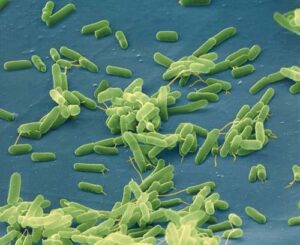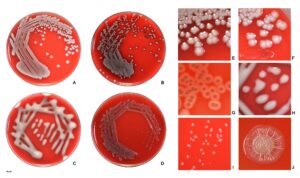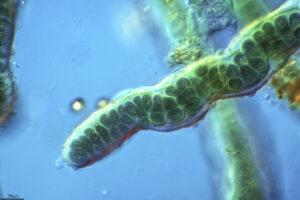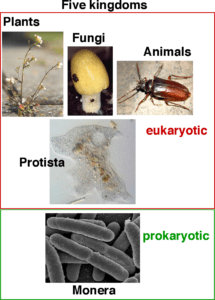In this article, we will see Monera, characteristics of Monera, and types of Monera. In addition, we will look at monera examples too.
Let us see the monera examples.
E.coli
It stands for Escherichia coli. It is generally found in the intestine of animals. It is gram-negative bacteria. It is seen as rod-shaped and is mainly facultative anaerobes. Some of their species cause diarrhoea, respiratory infections, and pneumonia.

Asiatic cholera
It is also known as Vibrio cholerae. It is a comma-shaped, facultative anaerobic bacteria. It is originally found in the brackish area where they are found attached to the wall of crabs, shrimps, etc. It also causes a disease called Cholera in rural areas.
Hay bacillus
It is also known as Bacillus subtilis and grass bacillus. It is a gram-positive bacteria. It is seen in soil, the gastrointestinal tract of humans, sponges, and ruminants. They form spores and are motile in nature. They can also withstand adverse environments by forming spores. It is a soil bacteria. It is the most common monera example.
Helicobacter Pylori
It was known as Campylobacter pylori. It is gram-negative and found to spiral in shape. The stomach is the area where it is present in various organisms. It is the most common monera example.

Anthrax bacterium
It is also called Bacillus anthracis. It is a gram-negative disease-causing bacteria. It causes Anthrax. It is proven deadly to human beings and other mammals. It is the most common monera example.
Staphylococcus aureus
It is a member of Bacillota. It is a gram-positive, sphere-shaped bacteria. It is seen in the skin and respiratory tract of the human body. It causes blood infections, pneumonia, and bone infections.
Clostridium botulinum
It is a gram-positive bacteria. It is rod-shaped, motile bacteria that have the capability to form spores. It is also found on fruits and vegetable surfaces. It also produces a neurotoxin and causes a disease called Botulism.

Treponema palladium
It is a type of spirochaete bacteria. It is a major organism causing a disease called Syphilis, bejel, and yaws. Syphilis is transmitted sexually or from mother to child.
Clostridium tetani
It is a very common soil bacteria and monera examples. It is an anaerobic, gram-positive bacteria that is found to be rod-shaped. It causes a disease called Tetanus. It is seen that the bacteria are sensitive to heat. It cannot survive when oxygen is present.
Pseudomonas aeruginosa
It is a common monera example that is very commonly found as gram-negative, aerobic, and rod-shaped. It causes a disease in human being called Aeruginosa. It spreads through bad or poor hygiene.
Streptococcus pneumonia
It is also known as pneumococcus. A gram-positive bacteria sphere in shape. It is anaerobic bacteria. They form spores and are normally non-motile. It is known to cause infection of the ear, sepsis, and pneumonia in children and adults, respectively. It is common monera examples.
Meningococcus
It is a gram-negative bacteria. Its scientific name stands for Neisseria meningitides. It causes a disease called meningitis which normally spreads through physical contact. It is the most common monera examples.
Gardnerella vaginalis
It is a facultative anaerobic bacteria. The organisms are small-spore-forming, immotile coccobacilli. It is the most common monera examples.

Klebsiella pneumoniae
The bacterium generally colonizes mortal mucosal shells of the oropharynx and gastrointestinal tract. It is a gram-negative bacteria and is seen to be associated with a disease called pneumonia.
Lactobacillus acidophilus
It is also called Acidiophillus which is a bacteria found in plants, animals and the human body and is mainly present in the vagina, and mouth. It is a good bacteria and is called probiotic bacteria. It helps to maintain the acid-base balance of the body.
Enterococcus faecalis
It belongs to the genus Enterococcus and acts as a probiotic bacteria in plants and animals. It is the most common monera examples.
Haemophilus influenza
Haemophilus influenza is a Gram-negative bacteria that beget a severe infection, substantially in babies and children younger than five times.
Group A streptococcus
Bacteria belonging to this group causes various disease and infections in human and animals. They are extracellular bacteria. They are non-motile and form spores. The spore is comma-shaped.
Chlamydia trachomatis
It is also known as Chlamydia and causes a disease called Chlamydia.
Neisseria gonorrhoeae
It is also known as Gonococcus. It is a gram-negative bacteria. It causes Gonorrhoeae. This disease affects the genital region or genital tract. It is the most common monera examples.
Mycobacter tuberculosis
It is a pathogen bacteria in which family Mycobacteriaceae and the causative agent of tuberculosis. The bacteria affects the lungs and other parts also sometimes.
What is Monera?
Out of five-kingdom, it is a kingdom of prokaryotic organisms that includes bacteria. Prokaryotic organisms do not have any cellular components or organelles. It does not have a nucleus, and genetic material is present in the nuclear membrane. They do not contain Those organisms that come under this kingdom generally reproduce by asexual mode of reproduction. In particular by budding or binary fission. They prepare food either by photosynthesis or chemosynthesis, which means they are autotrophic.

Monera is usually found in the plant, animal, and human bodies. They are found in a moist environment and are microscopic.
Archaebacteria
They are known as the oldest living organisms on Earth. It is present in various conditions like salt places, hot springs, etc. They have different tRNA and rRNA. They are different from eurl=kyotic organisms. Archaea is more divided into many recognized phyla. As a result, most haven’t been isolated in a laboratory and have solely been found in close samples by their factor sequences; classification is troublesome. When observed under a microscope, it shows behaviour like bacteria. Piecemeal from this, they’re fully distinct from prokaryotes. They occupy small similarities with eukaryotes.
Types-
Crenarchaeota
The Crenarchaeota are Archaea, which live in a broad range of territories. They can withstand high heat conditions due to the presence of some protein which helps to handle heat up to 230 degrees Celcius. They can be planted in deep- ocean reflections, etc.
Euryarcheota
These can survive extreme alkali conditions and are capable of producing methane, unlike any other living being on earth. These include methanogens and halophiles.
Korarchaeota
They contain hyperthermophiles.
Thaumarchaeota
These include archaea that oxidize ammonia.
Nanoarchaeota
It is a symbiotic archaeon which belongs to the rubric Ignicoccus. It is an obligate type.
Eubacteria
They are prokaryotic microorganisms conforming to a single cell lacking a nexus and containing DNA is a single indirect chromosome. Eubacteria can be gram-negative or gram-positive; they’ve profitable, agrarian, and medical significance.
They fall into three main shape orders. Globular eubacteria are called cocci; rod-shaped eubacteria are bacilli; helical or helically-shaped eubacteria are spirilla.
Cyanobacteria
They are found in marine areas and are photosynthetic in nature. It allows them to prepare their own food. Because they’re bacteria, they’re relatively small and generally unicellular, though they frequently grow in colonies large enough to see. Cyanobacteria are submarine and photosynthetic, i.e., they live in the water, and can manufacture their own food. Because they’re bacteria, they’re relatively small and generally unicellular, though they frequently grow in colonies large enough to see. In addition, they also contain colours similar to carotenoids and phycobilin.
These bacteria grow naturally in marine and brackish systems. They thrive in heads, gutters, budgets, lakes, and indeed in hot springs. These bacteria typically look green and occasionally turn blue when the proletariat is dying The corruption of these blooms depletes the oxygen and triggers the payoff of fish.
Also Read:
- How to find phenotypic ratio
- Bees examples
- Example of coenzyme
- Do eukaryotes have a nucleus
- Carbohydrates polymer examples
- Do prokaryotes have exons
- Mitochondria and endoplasmic reticulum
- Unicellular fungi examples
- Do prokaryotes have telomeres
- Nucleotide examples

Hi…I am Arti Pandey, have a Master’s degree in Biotechnology. I am an academic writer in Lambdageeks and also a beginner Korean learner. I love to explore new cultures, places, and food. I love photography and had a keen interest in creative writing.